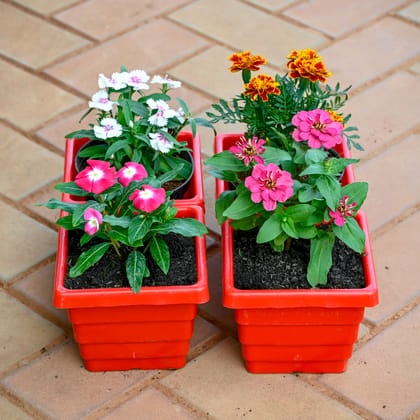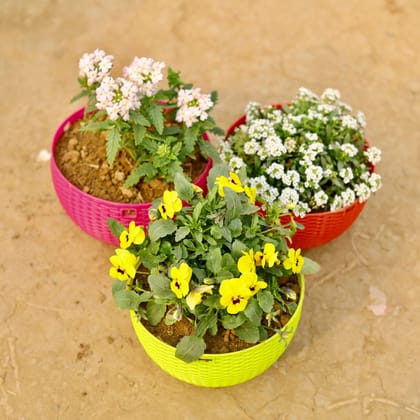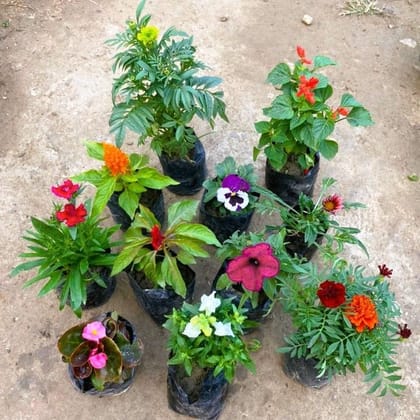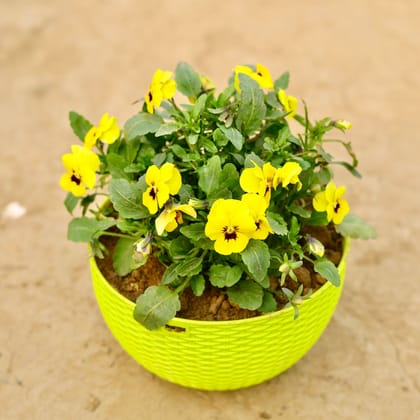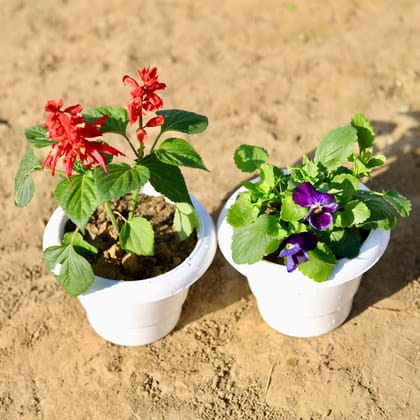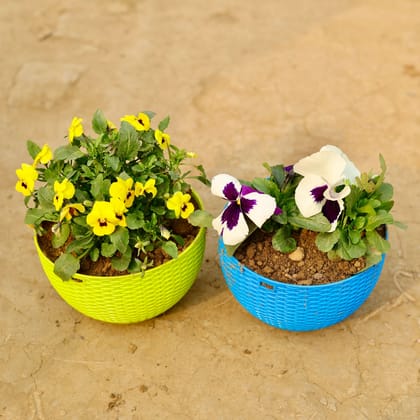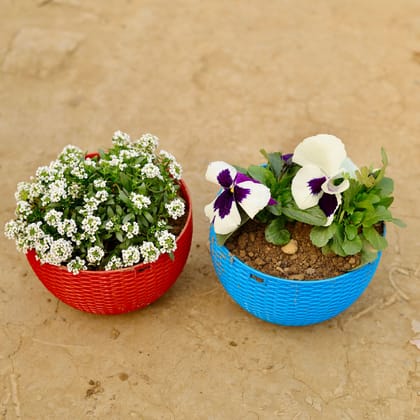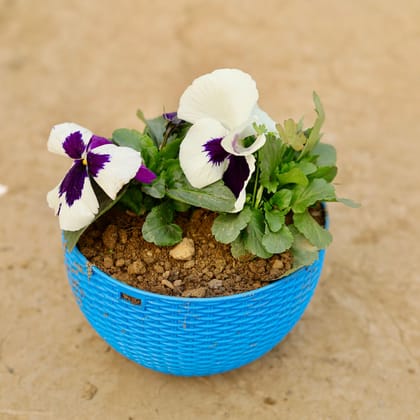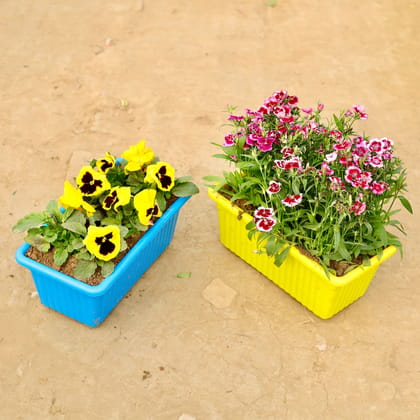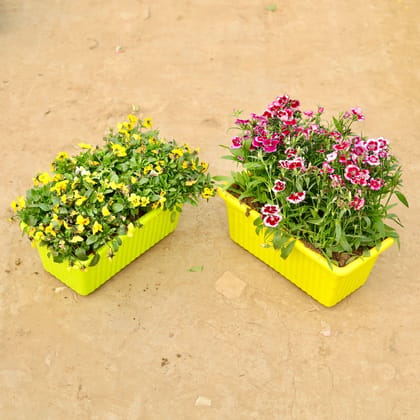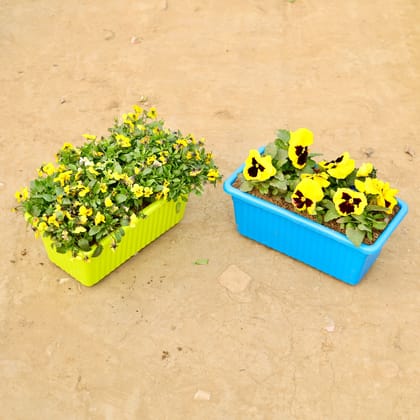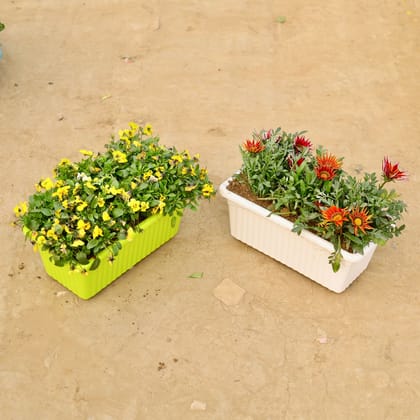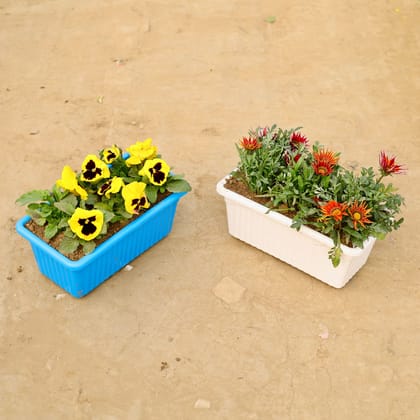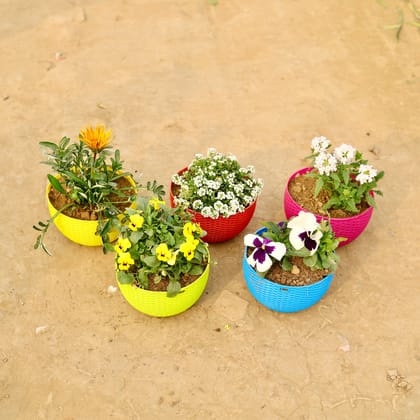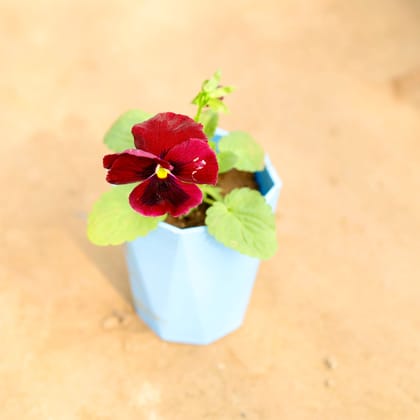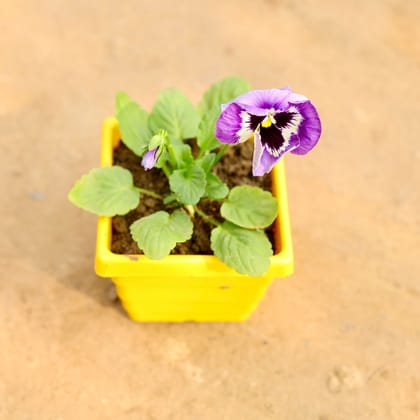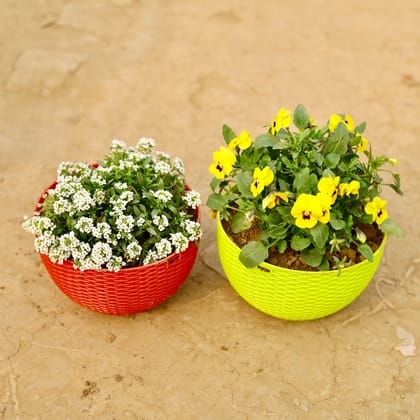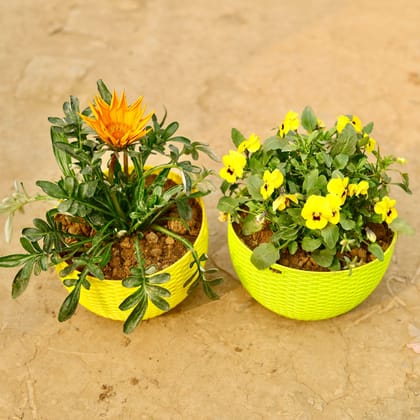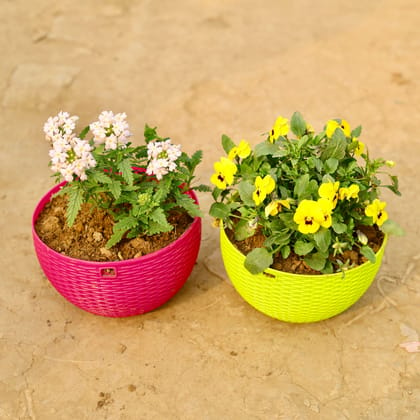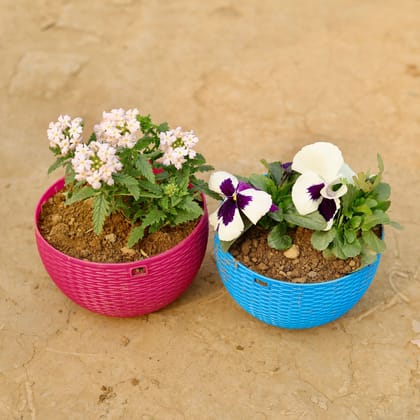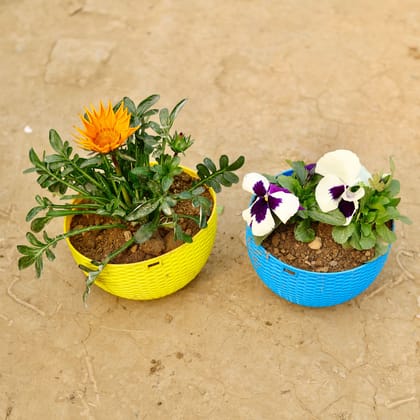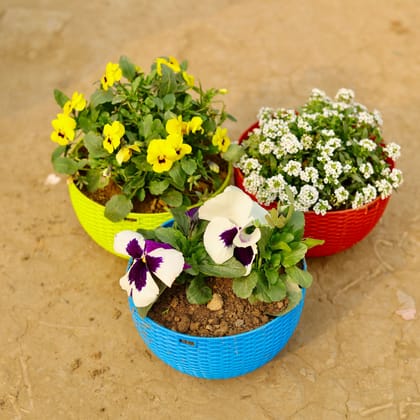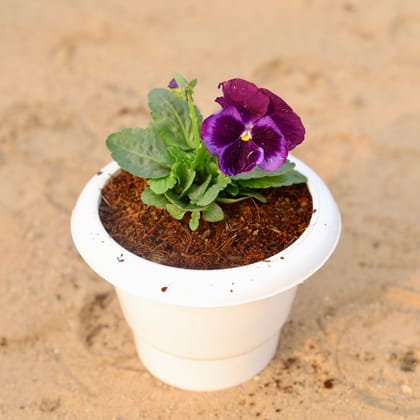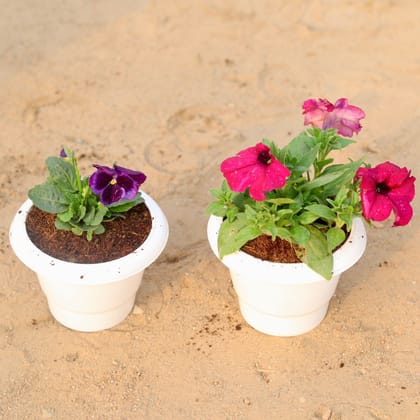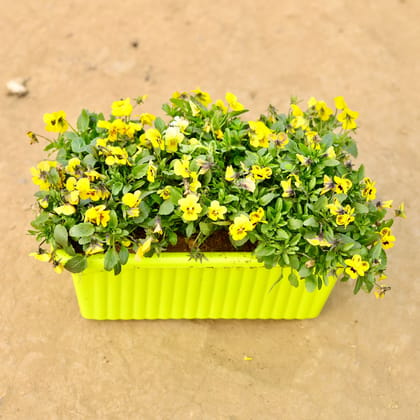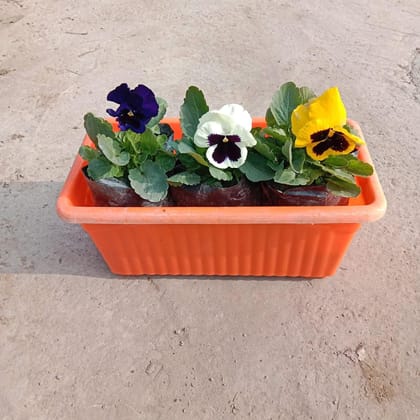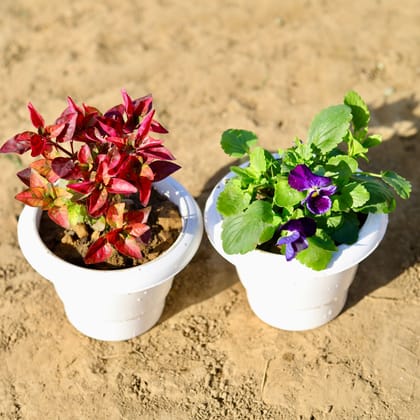- Plants
- Plants
- Pots
- Pots
- Soil & More
- Soil & More
- Home Decor Plants
- Home Decor Plants
- Seeds
- Seeds
- Tools
- Tools
- Gifting
- Gifting
- Bulk Gifting
- Bulk Gifting
- Others
- Others
- Sale
- Sale
- Best Sellers
- Best Sellers
Urvann is your one-stop online nursery for plants, planters, gardening accessories, and tools. Order fresh plants and get free home delivery on the next day!
EN- Home
- Pansy Collection
Pansy Collection
Buy Pansy Plants Online at Urvann
One of the most cheerful flowers of the winter season is the stunning Pansy plant that spreads a riot of colours in your home garden.
It blooms prolifically in winter in North India, loving the cool weather and giving your garden a blissful and relaxing vibe. The plant's most unique feature is its flowers with face-like markings in the centre. Therefore, it is also known as the ‘face-flower plant’, making for pretty gardens. Pansies are seen in many colours, such as white, yellow, red, pink, and the most unique purple, with a yellowish centre. They belong to the violet family, Violaceae, and the flowers are almost heart-shaped, with overlapping petals in bright colours or bi-colours.
Why Should I Grow Pansy Plants
Pansies are colourful flowering plants that light up the mundane winter months when the cold is too much to bear. Here are a few benefits of growing this gorgeous plant:
Attracts PollinatorsPansies are delightful flowers that are constantly surrounded by hovering butterflies and bees. If you are lucky, you might see a hummingbird diving in for a sip of their sweet nectar. It is a joy to have them in your home, and they increase the biodiversity of your garden’s ecosystem. Pollinators ensure that the plant’s lifecycle continues to spread.
Low-MaintenancePansies are a delight for gardeners because they require little maintenance. Keep the soil moist, put them in a place receiving sunlight, and let them be. They thrive happily and reward you with delightful blossoms the entire season. If you want a flowering plant with minimum upkeep, this is for you.
Vibrant and Varied BloomsThe vibrant colours of Pansies can brighten up your home garden! They make fantastic focal points that will surely catch the eye and spark conversations with your guests. They'll be so enchanted that they'll wish they had these lovely flowers in their gardens, too.
Care Tips for Pansy Plants
The Pansy flower season in India lasts from October to late February. Here are some essential care tips to ensure you get the most out of your Pansy plants.
How much water makes my Pansy Plants happy?
Pansies love to have their root feet in moist soil . Ensure that the soil does not dry up entirely by sprinkling some water each day and that the planter has proper drainage holes. However, do not overwater, as that can damage the roots.
How much sunshine makes my Pansy Plant plants cheerful?
The Pansy is a cheerful plant that loves the sun, so ensure it gets about 6 to 7 hours of bright sunlight daily! It thrives during the winters in North India when the weather is between 10 and 15 degrees, chilly, and dry.
Which type of soil is best for growing the Pansy Plant?
To keep Pansy plants healthy, use a soil mix that drains well and contains nutrients. A good recipe includes 20% perlite or vermiculite for drainage, 20% Garden Soil for structure, 25% Cocopeat to hold moisture, and 25% Vermicompost for nutrients. Finally, 10% Neem Khali for natural pest control should be added.
When is the best time to fertilise my Pansy Plant?
Add vermicompost or homemade compost every month. Remember to check the instructions on your fertilizer packaging, as different brands have different guidelines.
Why Choose Urvann to Buy Pansy Plants Online?
Urvann presents an outstanding selection of plants, gardening tools, and accessories. If you want to purchase Pansy flower plants online for your home garden, you’re in the perfect spot. Our collection has some of the healthiest plants at pocket-friendly prices. We ensure that your products are delivered the next day with free delivery and without any transit damage. Our expert customer support services are always available to assist with plant-related queries or concerns.
FAQ About Pansy Plants
1. When should pansy seeds be sown in India for the best results?
Pansy seeds can be sown in India by late August so that the plant has the time to grow and start flowering by October or mid-November.
2. How long does it take for pansy seeds to germinate?
The Pansy seeds take 10-15 days to germinate. To encourage growth, place them in a shaded location.
3. What steps should I follow to prepare the soil before sowing pansy seeds?
Prepare the soil by enriching it with vermicompost and perlite to help the soil become more nutritious and well-draining.
4. Do pansy plants face issues with pests and diseases?
Pansy flowering plants are most susceptible to aphids, leaf hoppers, powdery mildew and caterpillars.
5. Are pansies a good choice for growing in containers or pots?
Pansies grow wonderfully in containers and pots. Although, keep the plant in a larger pot so that the roots do not struggle to growth.
6. What is the typical blooming period for pansy plants?
Pansies start blooming from late October to mid-February, brightening your gardens.
7. Is it possible to propagate pansies from cuttings?
Yes, it is possible to grow Pansies from stem cuttings, but it is better to grow them from seeds. An even better option is to buy established saplings so the plant has more chances of flowering.
8. How can I encourage more blooms in pansies?
To promote continuous blooming, deadhead flowers regularly to encourage more blooming and fertilize from time to time.
Buy Pansy Plants Online at Urvann
One of the most cheerful flowers of the winter season is the stunning Pansy plant that spreads a riot of colours in your home garden.
It blooms prolifically in winter in North India, loving the cool weather and giving your garden a blissful and relaxing vibe. The plant's most unique feature is its flowers with face-like markings in the centre. Therefore, it is also known as the ‘face-flower plant’, making for pretty gardens. Pansies are seen in many colours, such as white, yellow, red, pink, and the most unique purple, with a yellowish centre. They belong to the violet family, Violaceae, and the flowers are almost heart-shaped, with overlapping petals in bright colours or bi-colours.
Why Should I Grow Pansy Plants
Pansies are colourful flowering plants that light up the mundane winter months when the cold is too much to bear. Here are a few benefits of growing this gorgeous plant:
Attracts PollinatorsPansies are delightful flowers that are constantly surrounded by hovering butterflies and bees. If you are lucky, you might see a hummingbird diving in for a sip of their sweet nectar. It is a joy to have them in your home, and they increase the biodiversity of your garden’s ecosystem. Pollinators ensure that the plant’s lifecycle continues to spread.
Low-MaintenancePansies are a delight for gardeners because they require little maintenance. Keep the soil moist, put them in a place receiving sunlight, and let them be. They thrive happily and reward you with delightful blossoms the entire season. If you want a flowering plant with minimum upkeep, this is for you.
Vibrant and Varied BloomsThe vibrant colours of Pansies can brighten up your home garden! They make fantastic focal points that will surely catch the eye and spark conversations with your guests. They'll be so enchanted that they'll wish they had these lovely flowers in their gardens, too.
Care Tips for Pansy Plants
The Pansy flower season in India lasts from October to late February. Here are some essential care tips to ensure you get the most out of your Pansy plants.
How much water makes my Pansy Plants happy?
Pansies love to have their root feet in moist soil . Ensure that the soil does not dry up entirely by sprinkling some water each day and that the planter has proper drainage holes. However, do not overwater, as that can damage the roots.
How much sunshine makes my Pansy Plant plants cheerful?
The Pansy is a cheerful plant that loves the sun, so ensure it gets about 6 to 7 hours of bright sunlight daily! It thrives during the winters in North India when the weather is between 10 and 15 degrees, chilly, and dry.
Which type of soil is best for growing the Pansy Plant?
To keep Pansy plants healthy, use a soil mix that drains well and contains nutrients. A good recipe includes 20% perlite or vermiculite for drainage, 20% Garden Soil for structure, 25% Cocopeat to hold moisture, and 25% Vermicompost for nutrients. Finally, 10% Neem Khali for natural pest control should be added.
When is the best time to fertilise my Pansy Plant?
Add vermicompost or homemade compost every month. Remember to check the instructions on your fertilizer packaging, as different brands have different guidelines.
Why Choose Urvann to Buy Pansy Plants Online?
Urvann presents an outstanding selection of plants, gardening tools, and accessories. If you want to purchase Pansy flower plants online for your home garden, you’re in the perfect spot. Our collection has some of the healthiest plants at pocket-friendly prices. We ensure that your products are delivered the next day with free delivery and without any transit damage. Our expert customer support services are always available to assist with plant-related queries or concerns.
FAQ About Pansy Plants
1. When should pansy seeds be sown in India for the best results?
Pansy seeds can be sown in India by late August so that the plant has the time to grow and start flowering by October or mid-November.
2. How long does it take for pansy seeds to germinate?
The Pansy seeds take 10-15 days to germinate. To encourage growth, place them in a shaded location.
3. What steps should I follow to prepare the soil before sowing pansy seeds?
Prepare the soil by enriching it with vermicompost and perlite to help the soil become more nutritious and well-draining.
4. Do pansy plants face issues with pests and diseases?
Pansy flowering plants are most susceptible to aphids, leaf hoppers, powdery mildew and caterpillars.
5. Are pansies a good choice for growing in containers or pots?
Pansies grow wonderfully in containers and pots. Although, keep the plant in a larger pot so that the roots do not struggle to growth.
6. What is the typical blooming period for pansy plants?
Pansies start blooming from late October to mid-February, brightening your gardens.
7. Is it possible to propagate pansies from cuttings?
Yes, it is possible to grow Pansies from stem cuttings, but it is better to grow them from seeds. An even better option is to buy established saplings so the plant has more chances of flowering.
8. How can I encourage more blooms in pansies?
To promote continuous blooming, deadhead flowers regularly to encourage more blooming and fertilize from time to time.
- Sort ×
Urvann is your one-stop online nursery for plants, planters, gardening accessories, and tools. Order fresh plants and get free home delivery on the next day!
- Indoor Plants
- Low Maintenance Plants
- Flowering Plants
- Outdoor Foliage Plants
- Religious & Sacred Plants
- Air Purifying Plants
- Cactus & Succulents
- Good Luck Plants
- Plants by Location
- Plants of the Month
- Herbs-Medicinal & Vegetable Plants
- Fruit Plants
- Monsoon Plants
- Hanging Plants
- Potted Plants
- Bonsai Plants
- Special Plant Combos
- Bamboo Plant
- Pet Friendly Plants
- Plants to grow in Water
- Mosquito Repellent Plants
- Climbers & Creepers
Urvann India Private Limited
E-176
Delhi
Delhi 110060
IN
NEWSLETTER
Subscribe to get Email Updates!
Thanks for subscribe.
Your response has been recorded.
